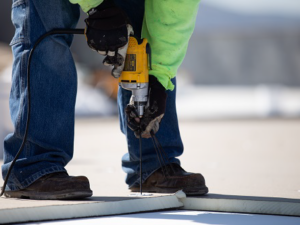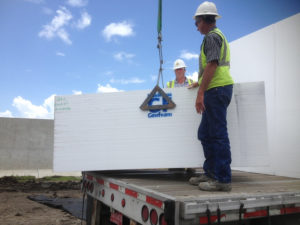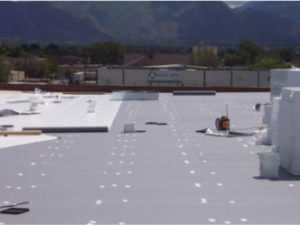
One of the primary ways that some of commercial architecture’s leading minds are contributing to their cities’ ecological health is through the design and implementation of green roofs. With their benefits to building aesthetics and their positive impact on the environment, it’s no wonder that companies like Facebook have turned away from conventional roofs in favor of ones that are urban oases of abundant vegetation.
Green roofs provide excellent external roof insulation while reducing heat island effects, wherein urban areas are significantly hotter than their rural surroundings. They also support biophilic design by providing occupants with a connection to nature. With the right materials and some application-specific knowledge, an environmentally friendly—and perhaps even newsworthy—green roof is well within reach.
What are green roofs?
A green roof can feature plant-life, trees, shrubs and even walking trails to create an outdoor living environment on top of a building. As such, they can help mitigate the effects of heat islands and in turn, support improved air quality and reduced water pollution.
Further, according to the EPA, “Green roofs can reduce building energy use by 0.7%… leading to an annual savings of $0.23 per square foot of the roof’s surface.” That energy reduction is due in part to green roofs’ ability to improve external roof insulation and to cool the roof’s temperature by 30-40°F compared to conventional designs. Decreasing energy use works in conjunction with carbon sequestration and storage to reduce greenhouse gas emissions.
While adding plant-life and outdoor amenities to a roof provides many benefits, it also increases the complexity of the roofing assembly. Among them are preventing moisture in
trusion and minimizing the roof assembly’s dead load. To address both of these complexities and more, many building professionals are turning to ultra-lightweight EPS geofoam.
Geofoam is ideal for green roofs
EPS geofoam is widely known for its ultra-lightweight composition, strength and customization capabilities, all of which make it an ideal material for green roof design. Plus, geofoam is 100% recyclable, without any HFC’s or formaldehyde.
Lightweight
Weighing as little as 0.7 pounds per cubic foot (compared to soil’s weight of approximately 110-120 pounds per cubic foot), the effective fill material is often employed to address a variety of geotechnical challenges, including lightening loads on commercial structures. For example, EPS geofoam made it possible for designers at Facebook’s MPK 20 office to create a nine-acre living roof, complete with hundreds of trees and a half-mile trail.
Designed for strength
Geofoam also has incredible compressive strength and load-bearing capacity, especially considering its lightweight composition. As an engineered product, manufacturers can customize the material to offer values ranging from about 317 to 2,678 pounds per square foot at a 1 percent strain. Assuming combined dead/live loads do not exceed the 1 percent strain designation, the material will not creep or experience plastic yield.
Resistant to moisture
EPS geofoam’s closed-cell structure means that it is also moisture-resistant, even over long-term exposure. Plus, it dries quickly. The moisture performance of the various components in a green roof assembly is critical; retained water imposes additional loads on the roof and increases the risk of water damage to the roof system.
Easily customizable
Because it’s made of EPS, geofoam can be cut and customized into nearly any size or shape. Designers can request customizations be made on the factory floor for the product to accommodate any shape, curve or slope. If needed, cuts can also easily be made on the jobsite with just a hot wire.
EPS geofoam’s versatility enables designers and architects to make their topographic visions a reality. From rolling hills to subtle valleys and beyond, soil and vegetation will follow the creative contours of the EPS geofoam base layer. While imaginative features like these would have added several tons of dead load to a roof if they were made out of soil or concrete, EPS geofoam’s lightweight construction enables creative and unusual possibilities without testing the roof’s weight capacity.
Geofoam makes green roofs easier to design
Green roofs improve a structure’s energy efficiency, building aesthetics and quality of life of the occupant or user. As sustainable and net zero construction becomes more necessary around the world, green roofs offer an environmentally friendly and aesthetic solution.
Strong and customizable EPS geofoam products like Insulfoam® GF are perfectly suited to support these efforts by simplifying the way green roofs are designed. If you’re a designer or architect looking to incorporate a green roof into your next building design, explore Insulfoam’s line of EPS geofoam products.





